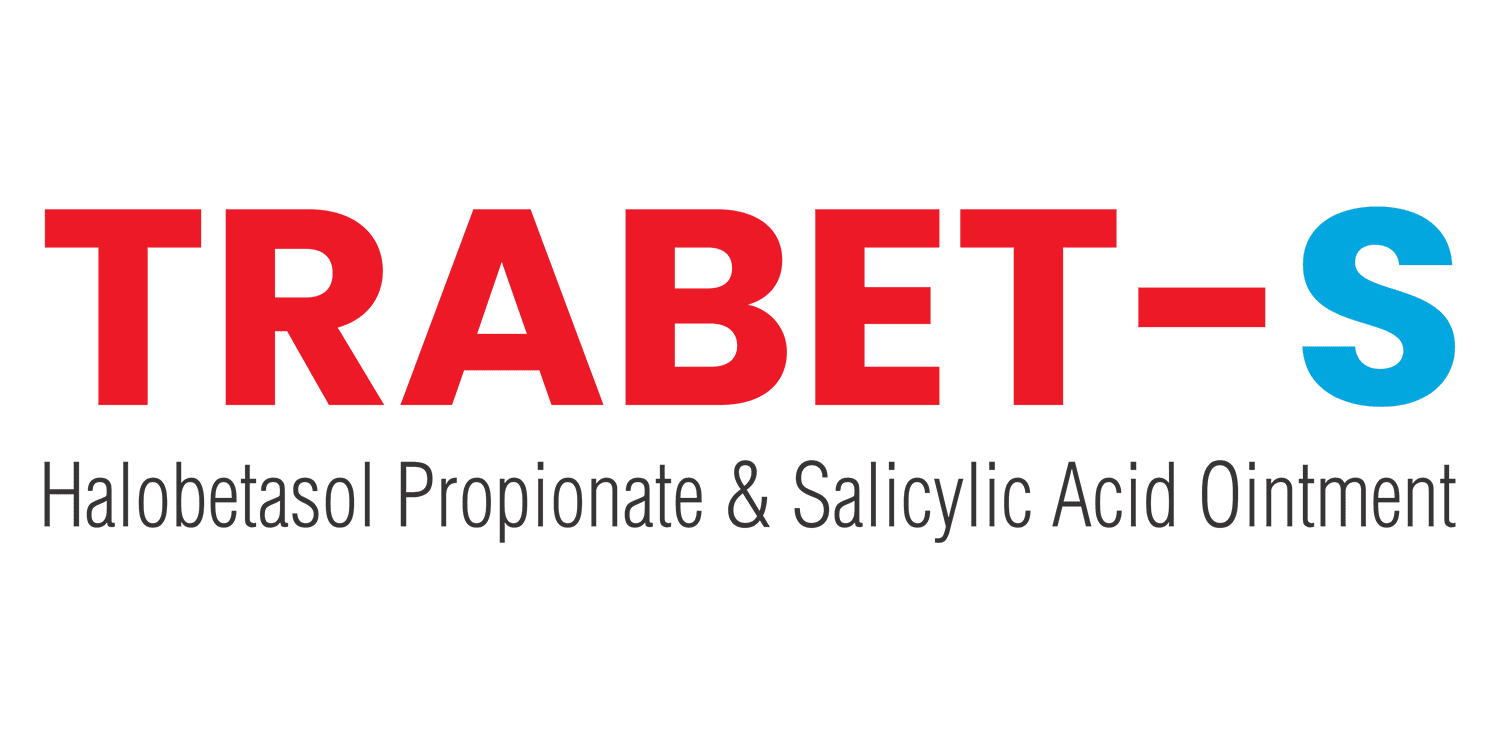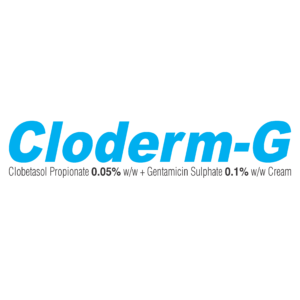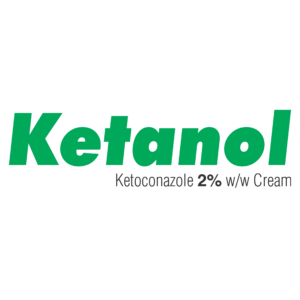TRABET-S
| Generic Name | Halobetasol Propionate & Salicylic Acid Onitment |
| Strength | 0.05% w/w & 3% w/w |
| Dosage form | Ointment |
Description
TRABET-S contains two active ingredients i.e. Halobetasol and Salicylic Acid which treat eczema and psoriasis. Halobetasol Propionate is a super-high potency corticosteroid indicated for the relief of inflammatory and pruritic manifestations of corticosteroid-responsive dermatoses. It blocks the production of certain chemical messengers (prostaglandins) that make the skin red, swollen and itchy. Salicylic Acid is a Keratolytic agent which breaks down keratin clumps, removes dead skin cells and softens the skin. It also enhances the absorption of Halobetasol Propionate into the skin.
 PATIENT INFORMATION LEAFLET
PATIENT INFORMATION LEAFLET
Read this Medication Guide before you start using this medicine because it contains important information for you
- Keep this leaflet. You may need to read it again.
- If you have any further questions, ask your doctor or pharmacist.
- This medicine has been prescribed for you only. Do not pass it on to others. It may harm them, even if their signs of illness are the same as yours.
- If you get any side effects, talk to your doctor or pharmacist. This includes any possible side effects not listed in this leaflet. See section 4.
What is in this leaflet:
- What TRABET-S is and what it is used for
- What you need to know before you use TRABET-S
- How to use TRABET-S
- Possible side effects
- How to store TRABET-S
- Contents of the pack and other information
1. What TRABET-S is and what it is used for
TRABET-S contains two active ingredients i.e. Halobetasol and Salicylic Acid which treat eczema and psoriasis. Halobetasol Propionate is a super-high potency corticosteroid indicated for the relief of inflammatory and pruritic manifestations of corticosteroid-responsive dermatoses. It blocks the production of certain chemical messengers (prostaglandins) that make the skin red, swollen and itchy. Salicylic Acid is a Keratolytic agent which breaks down keratin clumps, removes dead skin cells and softens the skin. It also enhances the absorption of Halobetasol Propionate into the skin.
2. What you need to know before you use TRABET-S
Do not use TRABET-S if you are allergic (hypersensitive) to Halobetasol Propionate & Salicylic Acid.
Warnings and precautions
Talk to your doctor or pharmacist before using TRABET-S:
- Halobetasol Propionate ointment has tendency to produce hypothalamic-pituitary-adrenal (HPA) axis suppression when used in divided doses at 7 grams per day for one week in patients with psoriasis. These effects are reversible upon discontinuation of treatment. If HPA axis suppression is noted, an attempt should be made to withdraw medicine in order to reduce the frequency of application, or to substitute a less potent corticosteroid. Recovery of HPA axis function is generally prompt upon discontinuation of topical corticosteroid.
- Pediatric patients may be more susceptible to systemic toxicity from equivalent doses due to their larger skin surface to body mass ratios.
- If irritation develops, TRABET-S should be discontinued and appropriate therapy instituted.
- If concomitant skin infections occur, an appropriate antifungal or antibacterial agent should be used. If a favorable response does not occur promptly, use of TRABET-S should be discontinued until the infection has been adequately controlled.
- TRABET-S should not be used in the treatment of rosacea or perioral dermatitis, and it should not be used on the face, groin, or in the axillae.
Other medicines and TRABET-S
Tell your doctor or pharmacist if you are taking, have recently taken or might take any other medicines. This includes any medicines which you have bought without a prescription.
Carcinogenesis, Mutagenesis, Impairment of Fertility
Long-term animal studies have not been performed to evaluate the carcinogenic potential of Halobetasol propionate. Positive mutagenicity effects were observed in two genotoxicity assays. Halobetasol propionate was positive in a Chinese hamster micronucleus test, and in a mouse lymphoma gene mutation assay in vitro. Studies in the rat following oral administration at dose levels up to 50 μg/kg/day indicated no impairment of fertility or general reproductive performance. In other genotoxicity testing, halobetasol propionate was not found to be genotoxic in the Ames/Salmonella assay, in the sister chromatid exchange test in somatic cells of the Chinese hamster, in chromosome aberration studies of germinal and somatic cells of rodents, and in a mammalian spot test to determine point mutations.
Pregnancy
Teratogenic effects:
Pregnancy Category C:
Corticosteroids have been shown to be teratogenic in laboratory animals when administered systemically at relatively low dosage levels. Some corticosteroids have been shown to be teratogenic after dermal application in laboratory animals.
Halobetasol propionate has been shown to be teratogenic in SPF rats and chinchilla-type rabbits when given systemically during gestation at doses of 0.04 to 0.1 mg/kg in rats and 0.01 mg/kg in rabbits. These doses are approximately 13, 33 and 3 times, respectively, the human topical dose of halobetasol propionate ointment, 0.05%. Halobetasol propionate was embryotoxic in rabbits but not in rats. There are no adequate and well-controlled studies of teratogenic potential of halobetasol propionate in pregnant women. TRABET-S should be used during pregnancy only if the potential benefit justifies the potential risk to the fetus.
Nursing Mothers
Systemically administered corticosteroids appear in human milk and could suppress growth, interfere with endogenous corticosteroid production, or cause other untoward effects. It is not known whether topical administration of corticosteroids could result in sufficient systemic absorption to produce detectable quantities in human milk. Because many drugs are excreted in human milk, caution should be exercised when TRABET-S is administered to a nursing woman.
Pediatric Use
Safety and effectiveness of halobetasol propionate ointment, 0.05% in pediatric patients have not been established and use in pediatric patients under 12 is not recommended. Because of a higher ratio of skin surface area to body mass, pediatric patients are at a greater risk than adults of HPA suppression and Cushing’s syndrome when they are treated with topical corticosteroids. They are therefore also at greater risk of adrenal insufficiency during or after withdrawal of treatment. Adverse effects including striae have been reported with inappropriate use of topical corticosteroids in infants and children.
HPA axis suppression, Cushing’s syndrome, linear growth retardation, delayed weight gain and intracranial hypertension have been reported in children receiving topical corticosteroids. Manifestations of adrenal suppression in children include low plasma cortisol levels and an absence of response to ACTH stimulation. Manifestations of intracranial hypertension include bulging fontanelles, headaches, and bilateral papilledema.
Geriatric Use
Of approximately 400 patients treated with halobetasol propionate ointment, 0.05% in clinical studies, 25% were 61 years and over and 6% were 71 years and over. No overall differences in safety or effectiveness were observed between these patients and younger patients; and other reported clinical experience has not identified differences in responses between the elderly and younger patients, but greater sensitivity of some older individuals cannot be ruled out.
Driving and using machines
This medicine should not have any effect on your ability to drive or use machines. Consult your doctor if you feel any side effect that may stop you from driving or using machines.
3. How to use TRABET-S
Always use this medicine exactly as your doctor or pharmacist has told you. Consult your doctor or pharmacist if you are not sure.
How to apply TRABET-S
Apply a thin layer of TRABET-S to the affected skin and rub in gently and completely. It is for external use only. Avoid contact with the eyes.
Remove the cap. Check the seal integrity before you first use the ointment. Then push the spike in the cap through the seal on the tube.
Always wash your hands before and after using TRABET-S.
How much TRABET-S to use
Apply TRABET-S to the affected skin once or twice daily, as directed by your physician.
Halobetasol propionate is a high potency topical corticosteroid; therefore, treatment of TRABET-S should be limited to two weeks, and amounts greater than 50g/wk should not be used. As with other corticosteroids, therapy should be discontinued when control is achieved. If no improvement is seen within 2 weeks, reassessment of diagnosis may be necessary.
TRABET-S should not be used with occlusive dressings.
If you use more TRABET-S than you should
Tell your doctor straight away if you have used more TRABET-S than you should because topically applied halobetasol propionate can be absorbed in sufficient amounts to produce systemic effects.
If you forget to use TRABET-S
If you forget to use an ointment at the right time, use it as soon as you remember. Then use this medicine again at the usual time.
Do not use a double dose to make up for a forgotten dose.
If you have any further questions about using this medicine, please ask your doctor or pharmacist.
4. Possible side effects
The most frequent adverse events reported for halobetasol propionate ointment, 0.05% w/w includes
stinging or burning in 1.6% of the patients.
Less frequently reported adverse reactions are postulation, erythema, skin atrophy, leukoderma, acne, itching, secondary infection, telangiectasia, urticara, dry skin, miliaria, paresthesia, and rash.
The following additional local adverse reactions may occur more frequently with halobetasol propionate ointment, 0.05% w/w. These reactions are listed in an approximate decreasing order of occurrence: folliculitis, hypertrichosis, acneiform eruptions, hypopigmentation, perioral dermatitis, allergic contact dermatitis, secondary infection, striae and miliaria.
Reporting of side effects
If you get any side effects, talk to your doctor or pharmacist. This includes any possible side effects not
listed in this leaflet.
5. How to store TRABET-S
Keep this medicine out of the sight and reach of children. Do not use TRABET-S after the expiry date on the tube or carton. The expiry date is the last day of that month.
Do not store the medicine above 30°C.
Do not throw away any medicines via wastewater or household waste.
Ask your pharmacist how to throw away any medicines you no longer use. These measures will help protect the environment.
6. Contents of the pack and other information
What TRABET-S contains
The active substance is halobetasol propionate & Salicylic Acid.
Composition:
Halobetasol Propionate USP 0.05% w/w
Salicylic Acid IP 3% w/w
In an ointment base q.s.
What TRABET-S looks like and contents of the pack
TRABET-S ointment is available in aluminium collapsible tubes in the pack size of 30 g.




